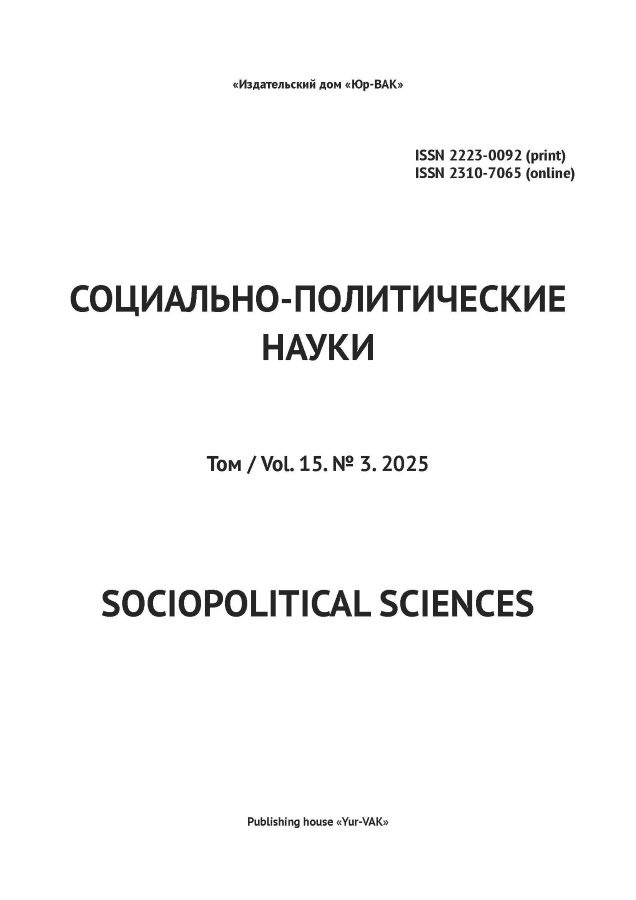Cross-Border Cooperation Between Russia and Mongolia Against the Backdrop of Intercivilizational Interaction
- Authors: Aksenov O.V.1, Zheleznyakov A.S.1,2, Nikiforov S.V.1,2
-
Affiliations:
- Institute of China and Modern Asia of the Russian Academy of Sciences
- Institute of Sociology – a branch of the Federal Center of Theoretical and Applied Sociology of the Russian Academy of Sciences
- Issue: Vol 15, No 3 (2025)
- Pages: 122-130
- Section: International Relations, Global and Regional Studies
- URL: https://journals.eco-vector.com/2223-0092/article/view/687867
- DOI: https://doi.org/10.33693/2223-0092-2025-15-3-122-130
- EDN: https://elibrary.ru/SRXBJC
- ID: 687867
Cite item
Abstract
The purpose of the research. The article addresses the today’s Russian-Mongolian economic and humanitarian cross-border cooperation, with their intercivilizational contacts, which have deep historical roots, being its driving force. The purpose of the research is to outline the main trends in the dynamics of the mentioned tracks of cross-border interaction, which is developing on the territory of the Russian-Mongolian intercivilizational outpost – the Republic of Buryatia, the Republic of Tuva, the Altai Republic, the Trans-Baikal Territory and the Irkutsk Region. Results. As a result of the research, the authors come to the following conclusions. First, the trade and tourism potential of the state border between Russia and Mongolia is partly fulfilled because of the poor participation of half of the available checkpoints. Second, the Russian regions have clear trade surplus with Mongolia because of the considerable diversification of their export. Third, the scale of cooperation between our regions and Mongolia differs significantly: the Republic of Buryatia and the Irkutsk Region operate on a national scale, while local projects in the Mongolian border aimags remain the main activities of the Republic of Tyva, the Altai Republic and the Trans-Baikal Territory. The authors hope that the regions of Russia and Mongolia will not only strengthen cross-border cooperation, but will also move towards a multidimensional consolidation of these civilizational outposts.
Full Text
About the authors
Oleg V. Aksenov
Institute of China and Modern Asia of the Russian Academy of Sciences
Author for correspondence.
Email: aksenov@iccaras.ru
ORCID iD: 0009-0007-4396-2081
Junior Researcher at the Sector for Mongolian Studies
Russian Federation, MoscowAlexander S. Zheleznyakov
Institute of China and Modern Asia of the Russian Academy of Sciences; Institute of Sociology – a branch of the Federal Center of Theoretical and Applied Sociology of the Russian Academy of Sciences
Email: zhelezniakov@iccaras.ru
ORCID iD: 0000-0002-6477-6161
SPIN-code: 7856-7694
Dr. Sci. (Polit.); Chief Researcher, Head of the Sector for Mongolian Studies; Chief Researcher, Head of the Center for Civilizational and Comparative Political Studies
Russian Federation, Moscow; MoscowSvyatoslav V. Nikiforov
Institute of China and Modern Asia of the Russian Academy of Sciences; Institute of Sociology – a branch of the Federal Center of Theoretical and Applied Sociology of the Russian Academy of Sciences
Email: nikiforov@iccaras.ru
ORCID iD: 0000-0003-3842-4848
SPIN-code: 2443-1245
Cand. Sci. (Law), Cand. Sci. (Pedag.); Senior Researcher at the Sector for Mongolian Studies; Senior Researcher, Scientific Secretary at the Center for Civilizational and Comparative Political Studies
Russian Federation, Moscow; MoscowReferences
- Arzumanov A.A. Culture-confessional factor in the consolidation processes of sociopolitical space of the Baikal Siberia. Bulletin of Irkutsk State University. Series: Politics, Regional Studies. 2009. No. 1. Pp. 244–250. (In Rus.). EDN: MTCQMX.
- Arutyunov S.A. Silhouettes of ethnicity against the civilizational background. Moscow, 2012. 416 p.
- Bazarov B.V., Badaraev D.D., Tsyrenov Ch.Ts. et al. Russia, Mongolia, China: Historical projections of interaction between the nations. Oriental Studies. 2023. Vol. 16. No. 4. Pp. 727–741. (In Rus.). doi: 10.22162/2619-0990-2023-68-4-727-741. EDN: FUAVAS.
- Zhalsanova V.G. Inter-ethnic relations in the Republic of Buryatia in the modern period (the results of a sociological study). Theory and Practice of Social Development. 2020. No. 3 (145). Pp. 18–22. (In Rus.). doi: 10.24158/tipor.2020.3.2. EDN: AYNFTF.
- Zheleznyakov A.S., Nikiforov S.V. A role of Buddhism in the shaping of common outposts for Russian and Mongolian civilizations. Oriental Studies. 2024. Vol. 17. No. 5. Pp. 1021–1036. (In Rus.). doi: 10.22162/2619-0990-2024-75-5-1021-1036. EDN: XVFXJU.
- Mikhalev A.V. “Soft Power” of today’s Mongolia and the border regions of Russia. Russia and Modern World. 2014. No. 1 (82). Pp. 93–101. (In Rus.). EDN: RYYRFH.
- Pokaninova E.B. Inter-religious and state-confessional relations in the Republic of Kalmykia: Past and present. The Sociology of Power. 2010. No. 5. Pp. 66–74. (In Rus.). EDN: MVZILH.
- Savitsky P.N. The Eurasia continent. Moscow, 1997. 464 p.
- Toynbee A.J. A Study of history. E.D. Zharkov (transl. from Englich). Moscow, 2001. 640 p.
- Huntington S.P. The cash of civilizations? Foreign Affairs. 1993. Vol. 72. No. 3. Pp. 22–49.
Supplementary files









